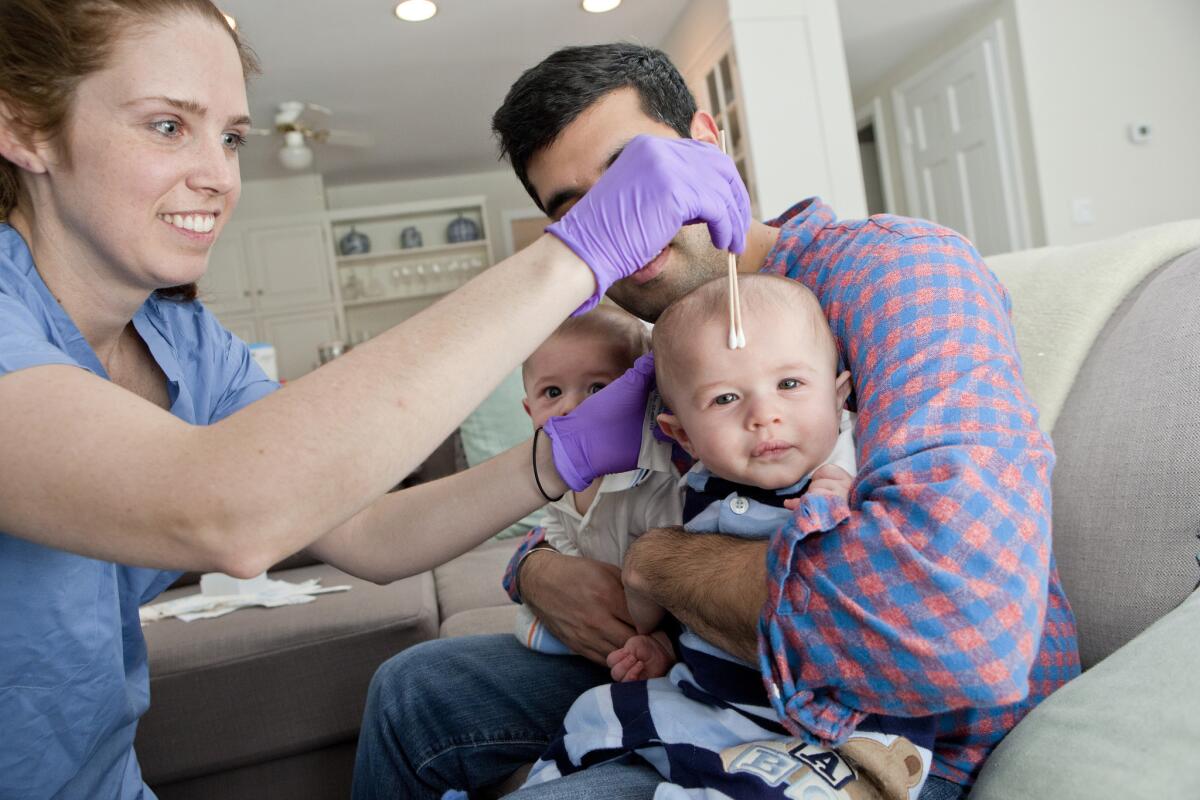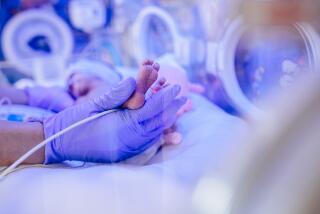Why doctors are swiping C-section babies with their mom’s microbiome

A new study aims to find out whether C-section babies can get the same microbes from their mothers as those born vaginally. Here, NYU senior research coordinator Nora Henderson collects samples of bacteria from twin boys in Mamaroneck, N.Y.
Are babies that are born by caesarean section at a disadvantage when it comes to future health risks? And can doctors do anything about it?
A new study in Nature Medicine aims to answer those two questions.
------------
FOR THE RECORD
An earlier version of this story said the study was published in the journal Nature Health. It appears in Nature Medicine.
------------
Previous research has shown a correlation (though not causation) between people who were born via C-section and an increased risk of obesity, asthma, allergies and autism.
One reason might be is that babies who are born via C-section do not pass through the mother’s birth canal and do not get exposed to the healthy microbes living there.
“Epidemiologically we know C-sections increase the risk of a lot of conditions. We also know it leads to a different microbiome from vaginal delivery,” said Rob Knight, director of the Center for Microbiome Innovation at UC San Diego and an author of the new paper. “What we don’t know is if the reason the risk is greater is because of the difference in the microbiome.”
In the new work, Knight and his colleagues found that the microbiome of infants birthed vaginally were enriched with Lactobacillus and Bacteroides, two species of bacteria that are abundant in the maternal vagina and have been shown to teach an infant’s immune system how to recognize and not attack other species of helpful bacteria.
However, babies that are born via C-section are lacking those helpful bacteria instructors. Their microbiota immediately after birth more closely resemble the community of microbes found on human skin.
In the new study, the researchers wanted to see whether they could help C-section babies get the same potential microbial benefits as babies who are born vaginally.
They recruited 18 infants and their mothers. Seven of the infants were vaginal deliveries, and 11 were born by scheduled C-section. Four of the C-section babies were exposed to their mother’s vaginal fluids within the first two minutes after birth. To do that, the researchers swiped the babies’ mouths, face and skin with a piece of sterile gauze that had been “incubating” in the mother’s vagina for one hour before the birth.
Then, the microbiomes of all 18 babies were tested six times over the next month from three sample sites: their tush, their mouth and their skin.
After sequencing the DNA of the different communities of microbes found on and in the babies, the researchers found that the microbiota of C-section babies swiped with vaginal fluid were more similar to vaginally birthed infants than to those who were delivered by C-section and not swiped.
Despite the exceedingly small sample size, the researchers still felt that the work was worth publishing.
“This is a proof of principle that if you expose a baby to vaginal fluids, the vaginal bacteria will pick up and bloom in different sites of the baby’s body,” said Maria Dominguez-Bello, a microbiologist at NYU and the lead author of the study.
However, the researchers note that the swiped babies did not pick up as many microbes as those born vaginally.
“It depends what species you are looking at,” Knight said. “For some taxa the transfer was essentially complete, but other taxa didn’t really take. We don’t have enough of an understanding yet to know whether that is because of genetics or differences in procedure. This is why we have to continue the research.”
The team is already at work on a larger study that will follow more babies and for longer periods of time to determine how much of a mother’s vaginal microbiome can be transferred to an infant, and what effects that will have on the baby’s health over time.
“This study shows we can restore, at least partially, the microbiome of the mother to the baby,” Knight said. “What we don’t know yet is how it reflects long-term health of babies.”
And one final note: The researchers do not recommend that women try this swiping procedure just yet. Mothers involved in the study were tested for signs of fungal and bacterial infections as well as other inclusion criteria in the days before the birth.
“We wanted to make sure this was a safe procedure, and that was something we can control for in our study,” said coauthor Jose Clemente of the Icahn School of Medicine at Mt. Sinai. “The take-home message is don’t do this at home. You want to make sure this procedure is done in a safe manner for the infant.”
Do you love science? I do! Follow me @DeborahNetburn and “like” Los Angeles Times Science & Health on Facebook.







